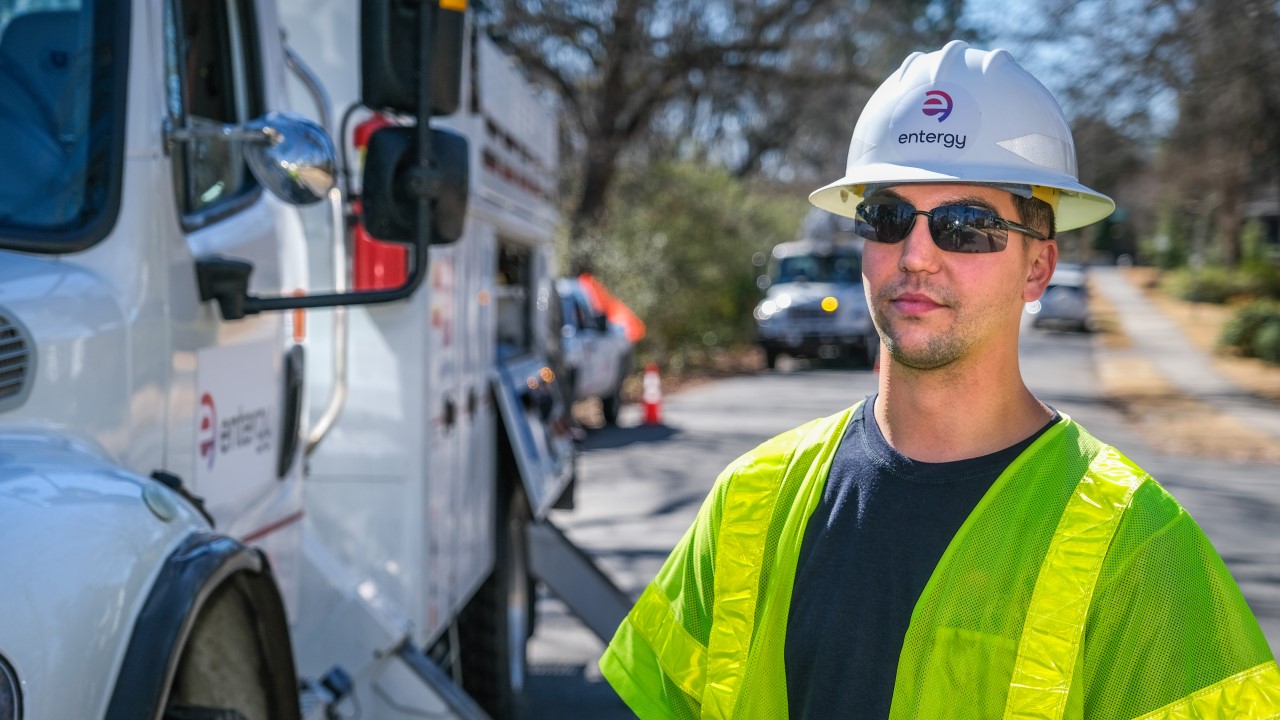
How lineworkers get the lights back on after severe weather
Entergy serves areas that are prone to some of the most severe weather in the United States: ice storms, tornadoes, violent thunderstorms and of course, hurricanes.
When there’s a big hurricane swirling in the Gulf of Mexico, and everyone along the coast is boarding up windows, filling cars with gas, and getting ready to evacuate, a lineworker gets ready, too. Lineworkers may be packing their own travel bags and hitting the road, but their route won’t take them away from the storm. They’ll head toward it.
“There are a lot of unknowns when you’re getting ready to be on the road and work storm,” said Kevin Rogers, senior lineworker. “Sometimes you get a little more warning, and sometimes you don’t have much time at all to get packed up and ready. You’re hoping you aren’t forgetting anything. You’re thinking some about what’s coming up at home that you might miss. There’s just a lot going through your mind.”
Once workers arrive in the area, they check-in for safety briefings and discussions about work and expectations. Then, they head to their designated staging area to wait out the storm and be ready for response after landfall.
“We used to all leave those check-in sites at once, together, in a big line of trucks,” added Rogers. “Now, we try to break into a few smaller groups, so we don’t overwhelm the highways and cause traffic and congestion for the public.”
Restoring at home
For lineworkers, storm duty is a different kind of work, and one they’re very passionate about. And when severe weather hits the area in which they live, restoration becomes personal. Though these employees often have damage to their own houses or property, they begin restoring power as soon as it’s safe to help the whole community recover more quickly.
‘It’s the absolute worst when a bad storm hits your own area,” noted Rogers. “Those customers you’re seeing, those are people you know, people you go to church with, people you go to the ballpark with. And sometimes, you have damage to your own house or property. I lost some of my roof in a storm a few years ago. I had water coming into my house, and I was out working. You’re trying to focus solely on your work, but it’s human nature to worry about your family.”
During storm restoration, lineworkers work with scouts, vegetation crews, and an extended army of other workers to turn the lights back on. Storm restoration makes for long hours for the entire contingent of workers. Lineworkers typically work 16-hour days, followed by eight hours of mandated rest time, to turn lights back on after major weather events. They are often some of the first responders to enter a ravaged area.
During a restoration, lineworkers may be dealing with height, high tension lines, heavy equipment, adverse weather conditions (both extreme heat and extreme cold), flooding, ice, traffic, equipment access issues and hazardous driving conditions.
“We have the reputation of being a really good mutual assistance utility that follows safety rules and guidelines, and everyone in the industry knows our track record pretty well. There’s a lot of pride there.”
– Kevin Rogers, senior lineworker
Restoration on the road
And lineworkers don’t just restore after severe weather for their own companies. In the event of a major storm, restoration is such a huge job that reinforcements are required. Entergy partners with other utilities throughout the nation in mutual assistance agreements, lending a hand to each other if called in during widespread outage emergencies.
“When you’re working storm, you may or may not be working on a system or in an area you know,” continued Rogers. “Different areas have different setups and different systems. The terrain and the local wildlife may be different from what you’re used to. Obviously, your safety awareness is really heightened due to all that.”
Lineworkers often travel long distances to work in unfamiliar territory for weeks at a time, helping other communities recover from devastating weather. These workers sometimes sleep in tent cities and eat from catering trucks, far from their homes and families.
But for Rogers, it’s worth it.
“Restoration work is so much more rewarding than our basic, everyday grind,” Rogers adds. “Don’t get me wrong - people always need power. But when you go work a hurricane or big storm like that, you know people will be suffering. You’re rolling in there, and those customers are getting excited. You’re letting them know you’re there to help, and they’re glad to see you. Even if you’re out there working, and they come at you with their teeth showing, you have to think about what they’ve been through. It’s very rewarding to go do that work and see those people smile when they get their power restored.”
Mutual assistance companies meet annually to strengthen their partnership. Entergy currently participates in four different mutual assistance organizations.
“We have the reputation of being a really good mutual assistance utility that follows safety rules and guidelines, and everyone in the industry knows our track record pretty well,” Rogers says. “There’s a lot of pride there.”
